As PetsPaa, we can understand that deciding when to euthanize a cat with seizures can be exhausting because every pet owner wants to ensure that their feline companions receive the best care and treatment possible.
Seizures are common in cats, and various underlying conditions can cause them. Some seizures are manageable and can be treated with medications. In contrast, others may indicate a more serious issue and be hard to manage.
In this post, we will cover almost all important aspects of seizures in cats, including causes, symptoms, prevention, treatment possibilities, and recommendations for when to euthanize a cat with seizures.
Table of Contents
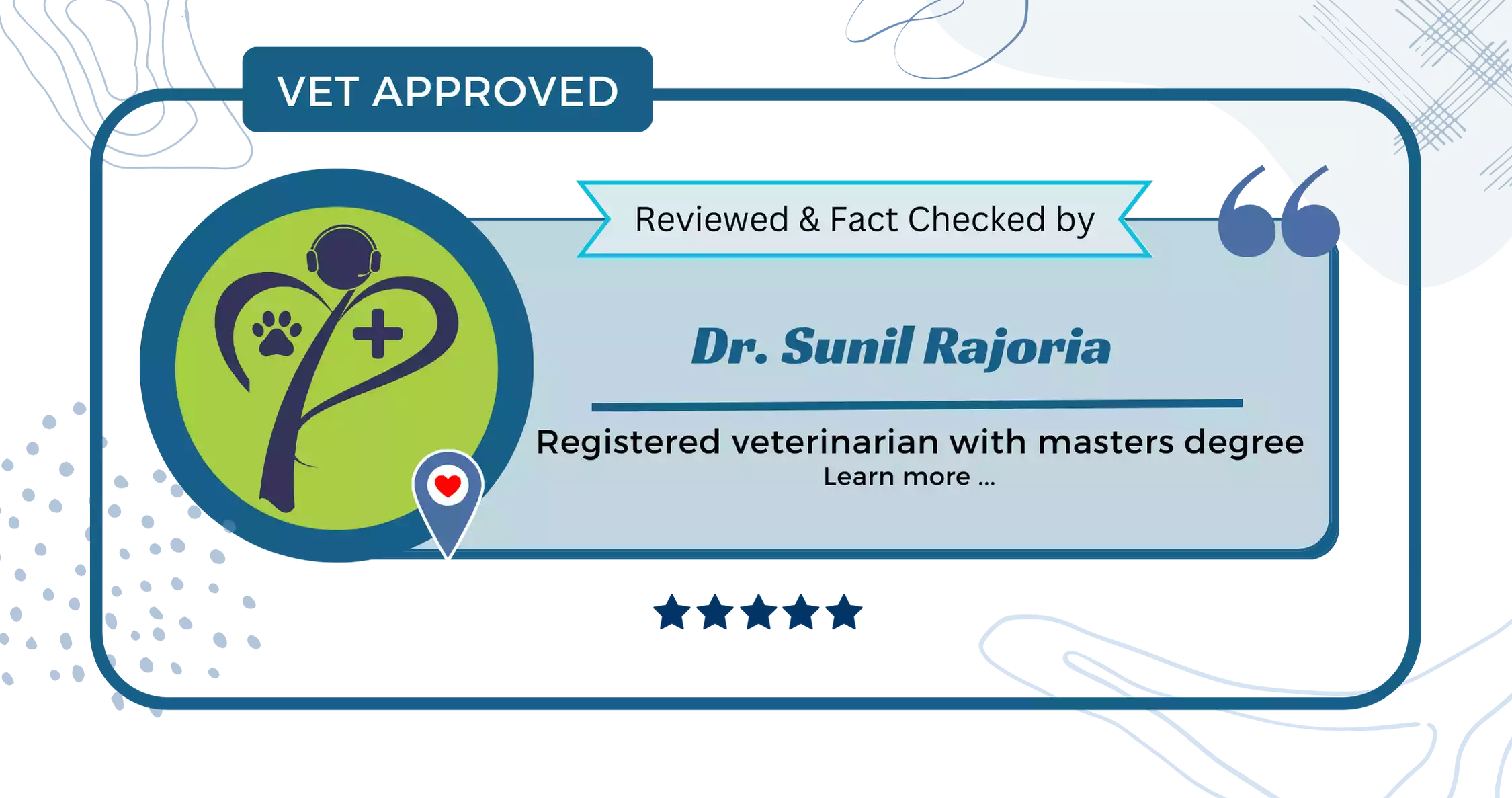
What Is A Seizure
A seizure is a sudden, uncontrolled electrical disturbance in the brain. During a seizure, a cat may exhibit signs and symptoms of convulsions, loss of consciousness, muscle twitching, drooling, and urinary or bowel incontinence. Seizures can vary in severity and duration and occur frequently or infrequently.
How Does It Affect A Cat
Seizures can affect cats in various ways depending on their severity and duration. During a seizure, a cat may feel muscle twitching, convulsions, loss of consciousness, drooling, and loss of urinary or bowel control.
These signs can be upsetting for both the cat and the owner. Seizures can also result in physical injuries, such as head trauma or broken bones if the cat falls or hits something while having a seizure. Also, repeated seizures may cause brain damage and reduced quality of life.
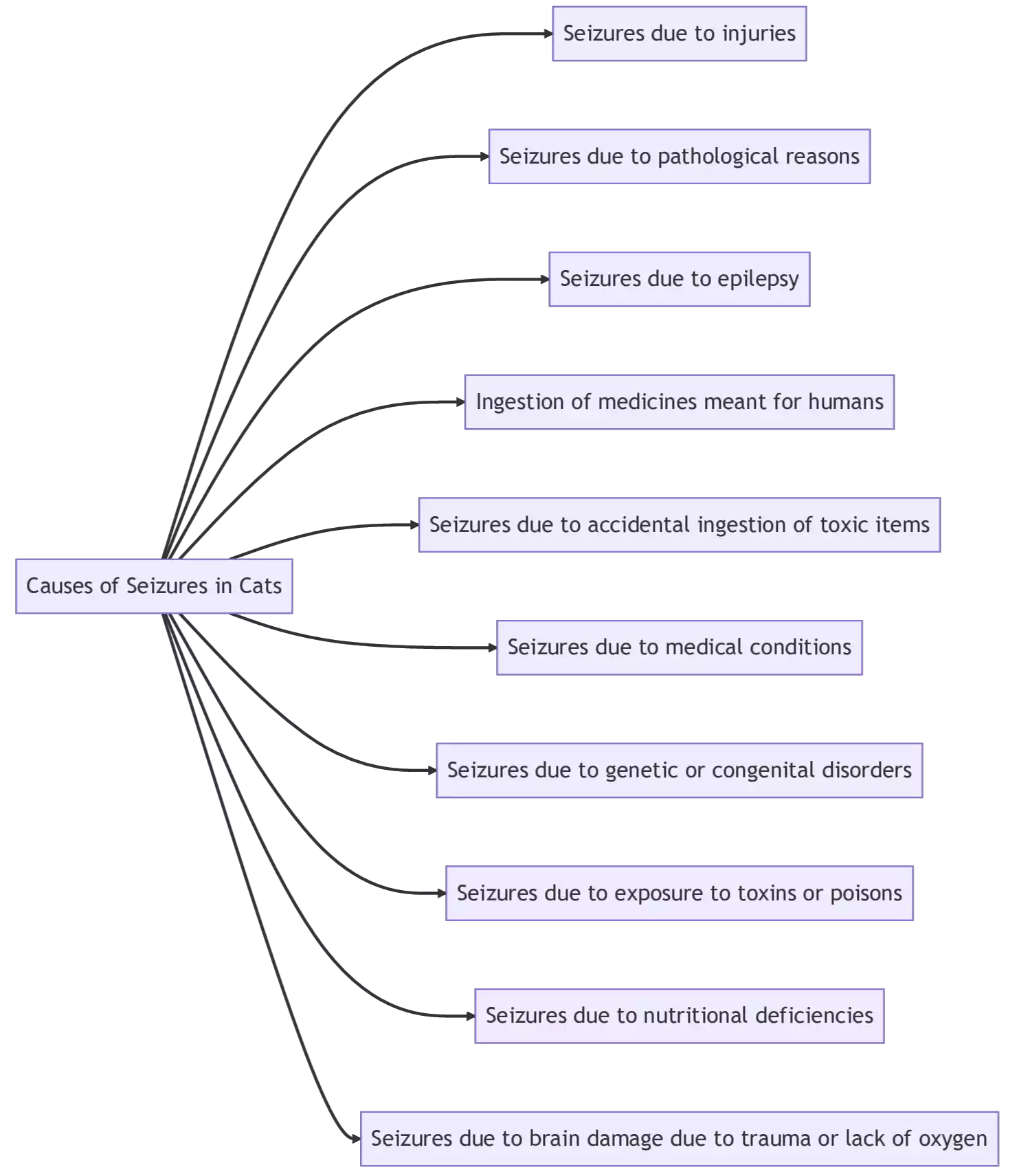
What Are The Causes Of Seizures In Cats
A variety of underlying medical conditions can cause seizures in cats. One of the most common causes is epilepsy, a neurological disorder characterized by recurrent seizures. Other potential causes include discussed below:
Seizures due to injuries
Head injuries or trauma can cause seizures in cats if your cat experiences a head injury or trauma. In that case, seeking veterinary care immediately is important to assess potential damage and prevent complications.
Seizures due to pathological reasons
Some diseases viz. Feline Infectious Peritonitis (FIP) or feline leukaemia virus (FeLV), may cause cat seizures. These diseases affect the nervous system of the cat, which causes seizures. Vaccination and frequent veterinarian examinations can aid in the prevention of these conditions.
Seizures due to epilepsy
Epilepsy is a neurological disorder that is responsible for recurrent seizures in cats. If the cause is unknown, medication can help control seizures in epileptic cats.
Ingestion of medicines meant for humans
Cats should never be given human medication without veterinary supervision. Accidentally ingesting human medication can cause seizures and other serious health problems.
Seizures due to accidental ingestion of toxic items
Cats may accidentally consume toxic substances such as lethal plants, chemicals, or poisons, which can induce seizures. Keep these products out of your cat’s reach and seek veterinarian treatment promptly if ingestion happens.
Seizures due to medical conditions
Medical conditions can interrupt normal brain activity and induce seizures. Other causes of seizures include brain tumours, liver disease, kidney or heart disease, diabetes, and hypoglycemia.
Seizures due to genetic or congenital disorders
Certain cat breeds are more prone to genetic disorders that can cause seizures. Before purchasing a cat, it is vital to do research and understand the breed’s potential health risks. Some of them are listed below:
- Siamese: Prone to asthma and certain dental issues.
- Persian: Prone to polycystic kidney disease (PKD) and kidney failure.
- Maine Coon: Prone to hypertrophic cardiomyopathy (HCM) that can cause seizures.
- Ragdoll: Prone to hypertrophic cardiomyopathy (HCM), just like Maine Coons.
- Sphynx: Prone to hereditary myopathy, which causes muscle weakness and seizures.
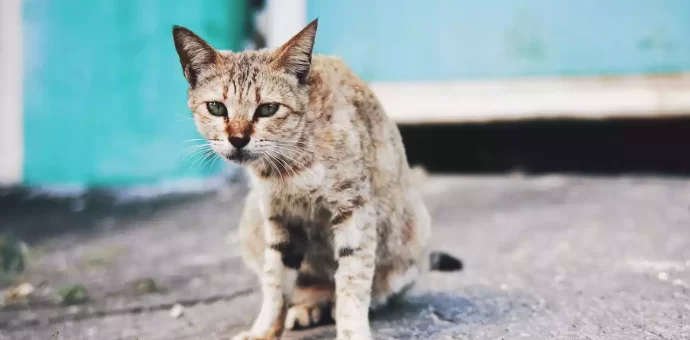
Seizures due to exposure to toxins or poisons
Exposure to toxins or poisons such as lead, antifreeze, or pesticides can cause seizures in cats. Keeping your cat away from potential toxins and seeking immediate veterinary care if ingestion occurs can prevent seizures.
Seizures due to nutritional deficiencies
Nutritional deficiencies can affect brain function and cause seizures in cats. Feeding a balanced and appropriate diet can help prevent nutritional deficiencies.
- Taurine deficiency: It is an essential amino acid for cats and its deficiency can cause various health issues, including seizures.
- Vitamin B1 or thiamine deficiency: Thiamine is essential for carbohydrate metabolism and nerve function and its deficiency may cause neurological issues, including seizures.
- Vitamin E deficiency: Vitamin E is an important antioxidant for neurological function. Vitamin E deficiency may cause neurological issues, including seizures.
Seizures due to brain damage due to trauma or lack of oxygen
Brain damage due to trauma or lack of oxygen can cause seizures in cats. Prevention of trauma and immediate veterinary care for oxygen deprivation can prevent seizures.
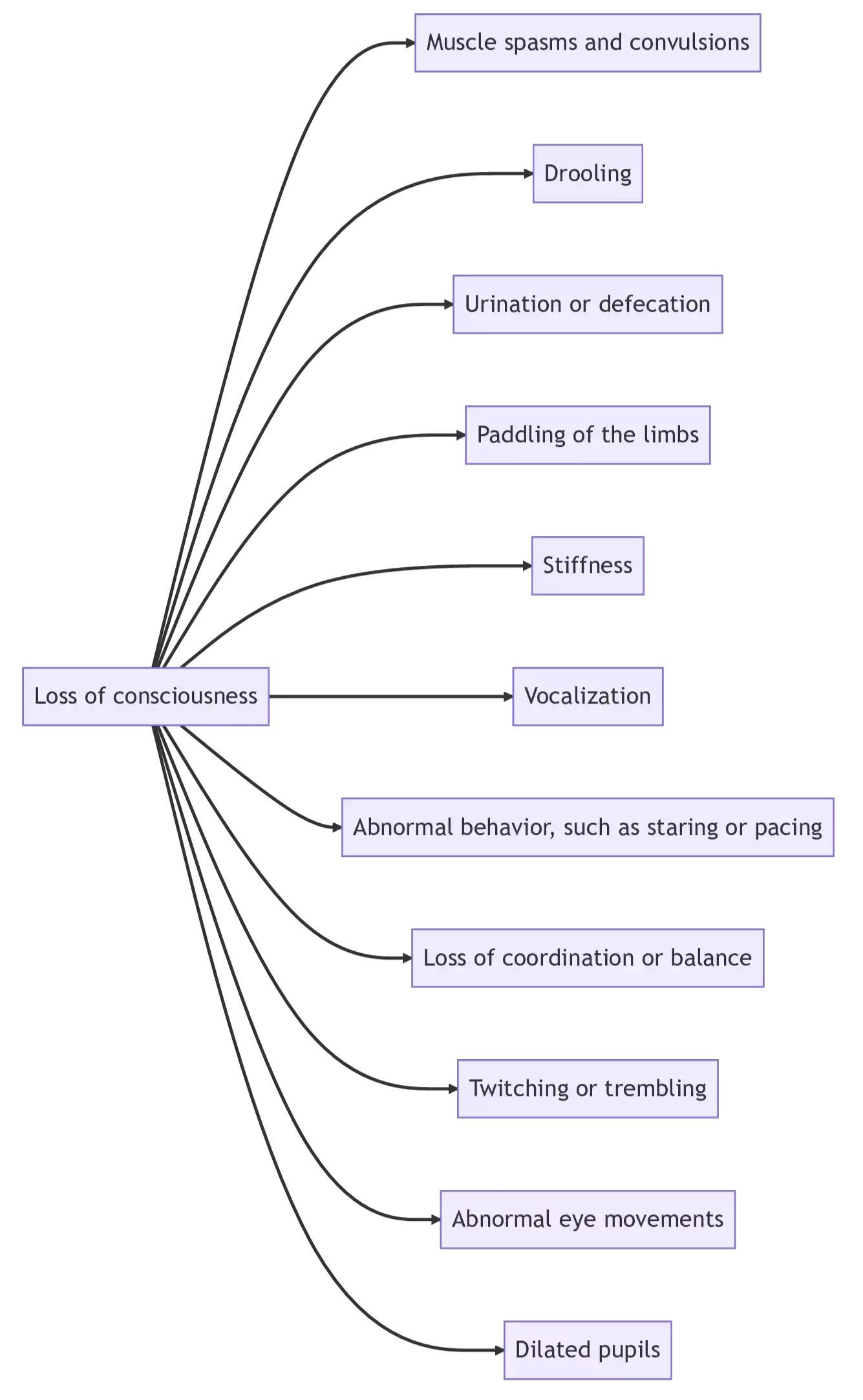
Signs and Symptoms of Seizures in Cats
Seizures in cats may be seen sometimes, and it’s important to recognize the common signs and symptoms so that appropriate medical attention can be sought in time. Below are some signs and symptoms of seizures in cats listed:
- Loss of consciousness
- Muscle spasms and convulsions
- Drooling
- Urination or defecation
- Paddling of the limbs
- Stiffness
- Vocalization
- Abnormal behavior, such as staring or pacing
- Loss of coordination or balance
- Twitching or trembling
- Abnormal eye movements
- Dilated pupils
If you sense that your cat is having a seizure, you should seek veterinary care within the time.
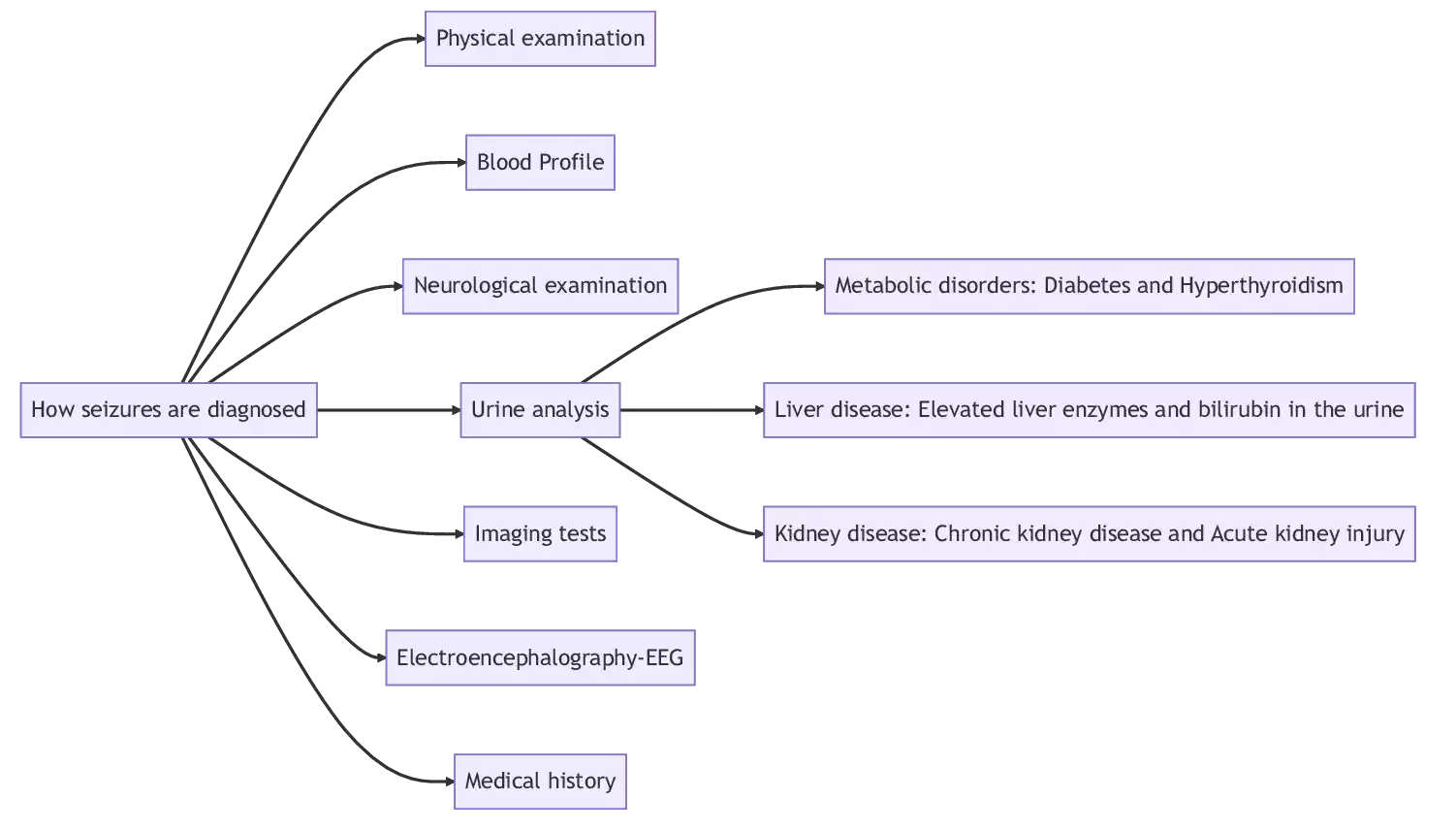
How seizures are diagnosed
Cat seizures might be difficult to detect. Your veterinarian may do a physical exam, blood, urine profile and imaging tests such as an MRI or CT scan to identify seizures in cats. Your veterinarian may also inquire about your cat’s medical history and any drugs which are currently on.
Physical examination
The first step in identifying seizures is a physical examination. The veterinarian will conduct a comprehensive body checkup on the cat, testing vitals, reflexes, and overall health.
Blood Profile
A Complete Blood Profile can help identify underlying medical conditions causing seizures, such as liver or kidney disease, infections, or low blood sugar.
Neurological examination
A neurological examination based on CT scans and MRI reports involves assessing the cat’s brain and nervous system function, looking for any signs of abnormalities or damage.
Urine analysis
Urine analysis can help to identify seizure-causing factors in cats:
- Metabolic disorders: Diabetes and Hyperthyroidism
- Liver disease: Elevated liver enzymes and bilirubin in the urine
- Kidney disease: Chronic kidney disease and Acute kidney injury
Imaging tests
An MRI or CT scan can assist in uncovering structural abnormalities, neurological diseases, or brain tumors responsible for seizures in cats.
Electroencephalography (EEG)
An EEG measures brain activity and can help diagnose epilepsy or other seizure disorders.
Medical history
A comprehensive medical history might offer vital clues regarding the underlying cause of seizures, such as past head traumas or a family history of seizures or epilepsy.
Prevention of Seizures in Cats
While some causes of seizures in cats, such as epilepsy or brain tumors, are unpreventable, there are some steps pet owners can take to help reduce the risk of seizures. These are some examples:
- Ensuring that cats are up-to-date on all vaccinations to prevent infections that can cause seizures
- Preventing exposure to toxins, such as pesticides and chemicals
- Providing a balanced and nutritious diet to support overall health
- Minimizing stress and anxiety, which can trigger seizures in some cats
- Providing regular exercise to maintain a healthy weight and reduce the risk of underlying medical conditions
- Changing the cat’s diet: A low-carbohydrate, high-fat diet may aid cats with epilepsy in certain cases.
- Management of underlying medical issues, such as liver or renal illness, can aid in the prevention of seizures.
- Avoiding seizure causes: Certain triggers, such as stress, loud sounds, and flashing lights, can cause seizures in certain cats. Avoiding these triggers can aid in seizure prevention.
- To manage seizures and avoid potential complications like fall injuries, providing supportive care to your cat if they experience seizures is important. This can involve keeping them in a secure and calm area during and after a seizure and seeking veterinary treatment as necessary.
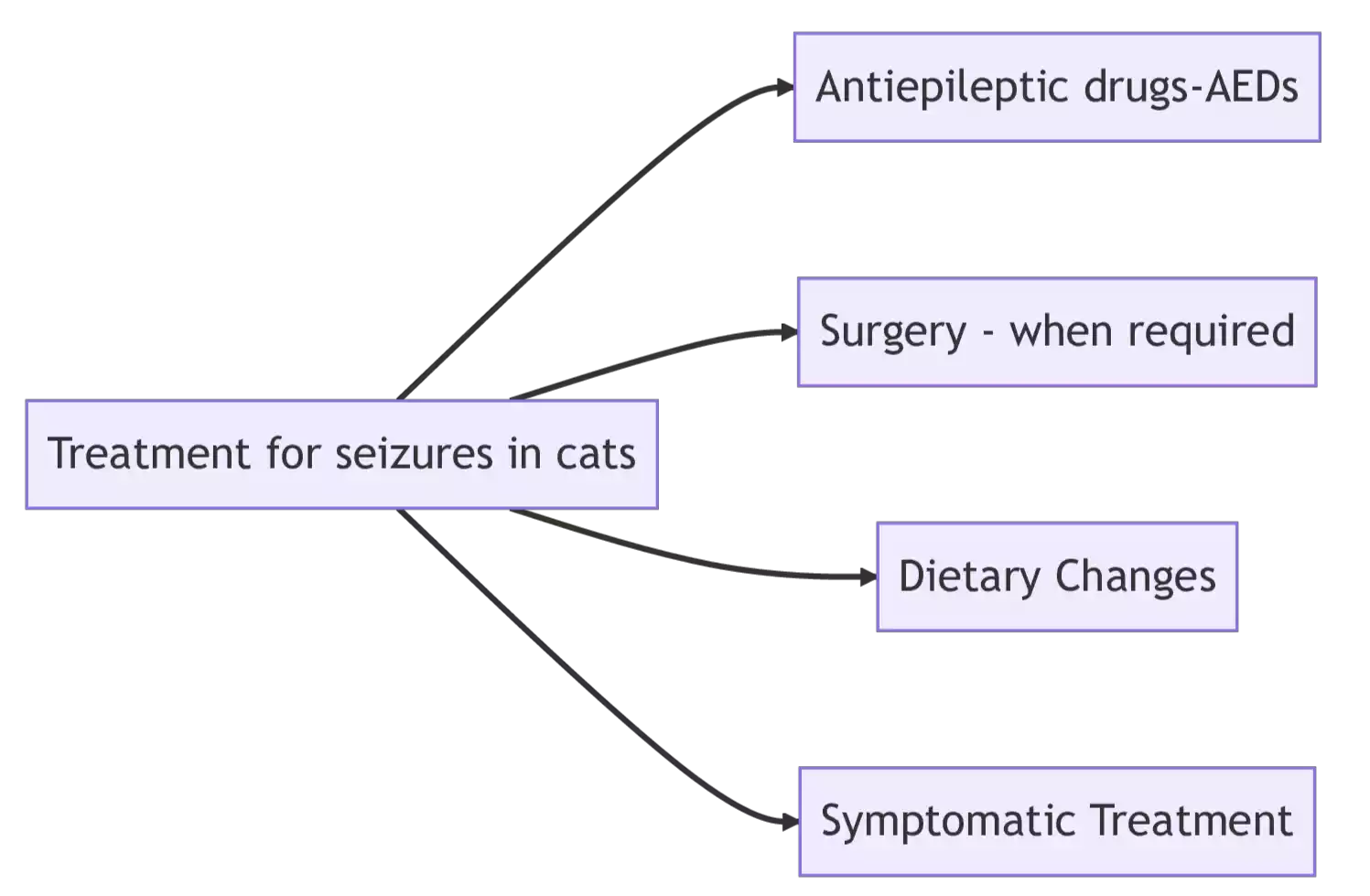
Treatment for seizures in cats
The underlying cause of a cat’s seizure will determine the appropriate course of treatment. Antiepileptic drugs (AEDs) such as phenobarbital or diazepam are frequently prescribed for cats with epilepsy to manage seizures.
Other therapies that may be considered include surgery to remove brain tumours or other underlying medical issues and dietary adjustments to improve overall health.
Antiepileptic drugs (AEDs)
Antiepileptic drugs (AEDs) viz. phenobarbital, diazepam, and potassium bromide are mostly used drugs to treat seizures in cats. These medicines decrease the activity in the brain that causes seizures.
Surgery
Surgery may be recommended to remove a brain tumour or address other underlying conditions that are causing seizures in cats.
Dietary Changes
Cats suffering from seizures may benefit from dietary adjustments such as switching to a low-carbohydrate or ketogenic diet. These foods may help some cats minimize the frequency and severity of seizures.
When to consider euthanasia for a cat with seizures
When to euthanize a cat with seizures is a difficult and emotional decision. If a cat does not respond to treatment and their quality of life suffers considerably, euthanasia may be considered. The following indications suggest euthanasia for a cat suffering from seizures:
- Unmanageable seizures: Frequent and severe seizures that are not controlled with medication or other treatments may be necessary to consider euthanasia to relieve the cat from suffering and pain.

- Incurable conditions: Seizures are not responding to treatment shows the severity of the underlying cause. In this case, euthanasia is the better option.
- Adverse effect on quality of life: If the seizures create negative consequences on quality of life, such as loss of appetite, incontinence, or other physical or mental suffering. It might be time to think about euthanasia.
- Significant pain or discomfort: If the cat is experiencing pain or discomfort due to their seizures or underlying condition, which cannot be effectively managed with medication or other treatments, euthanasia may be the kindest option.
- Cost of treatment is prohibitive: If the expense of treatment for the cat’s seizures is prohibitively expensive and imposes excessive financial stress on the owner, it may be essential to consider euthanasia as a humane choice.
- Progressive conditions: If the underlying cause of a cat’s seizures is a progressive condition, such as a brain tumor, euthanasia may be considered when the cat’s quality of life deteriorates.
- Poor prognosis: If a cat has a poor prognosis and is unlikely to recover or have a good quality of life, euthanasia may be a humane option.
- Progressive neurological disorders: that cannot be treated or managed effectively, such as advanced brain tumors or degenerative myelopathy.
- Chronic or severe medical issues that have resulted in multiple organ failures and reduced the cat’s quality of life, such as end-stage renal disease or congestive heart failure.
- Brain Damage: seizures that resulted in a considerable decline in cognitive function or serious, permanent brain damage.
It is essential to consult with a veterinarian consistently to decide the best course of action for your cat and ensure that all choices have been properly studied before deciding to put it to euthanize.

Coping with the loss of your pet
Losing a pet may be stressful and heartbreaking. Every person has different coping mechanisms. Dealing with the loss of a pet requires some time and patience. You can cope with the loss of a pet by using the tips that follow:
- Grieve and feel your emotions.
- Connect with family & friends for support.
- Create a memorial or tribute to your pet.
- Consider volunteering or donating to a pet-related cause in honour of your pet.
- Remember the happy times with your pet and cherish the memories.
- Give yourself time to heal and don’t rush the grieving process.
- Consider joining a pet loss support group
- Keep your pet’s belongings or create a keepsake
- Take care of yourself and seek professional help if needed
- Consider adopting another pet in the future if and when you feel ready.
Conclusion
Cat seizures may be a difficult and upsetting experience for pet owners. Understanding the effects, causes, symptoms, diagnosis, prevention, and treatment for seizures in cats will help us ensure that our feline pets receive the best possible care.
Some seizures are manageable and treatable with medicine; others may indicate a more serious problem. Pet owners must be informed of the typical signs and symptoms of feline seizures to get the proper medical assistance.
Veterinarians may do a physical examination, blood tests, and imaging tests like an MRI or CT scan to identify cat seizures. Choosing when to euthanize a cat with seizures might be challenging, but it might be the most compassionate choice in some circumstances.
It’s essential to consider your cat’s quality of life and go through your alternatives with your vet. Remember that it’s okay to grieve and ask for help from others during this difficult time.
FAQs (Frequently Asked Questions)
Brain tumors, epilepsy, toxins, chemicals, infections, and genetic susceptibility may all trigger seizures in cats.
The life expectancy of a cat suffering from seizures might vary depending on the underlying cause and the severity of the condition. Many cats with seizures can survive for many years from 1 to 7 years if given adequate medical treatment and care.
Seizures can happen to cats of any age, including older cats. Seizures in older cats can be caused by age-related disorders such as brain tumors, renal illness, or high blood pressure.
Yes, a cat can have seizures before dying, especially if the underlying condition causing the seizures is not well-managed. If your Cat seizure before death, you should meet a veterinarian to find out the cause.
Seizures are not usually painful for cats but can be disorienting and scary. However, if the underlying condition causing the seizures is painful, it may cause discomfort for the cat during the seizure.






